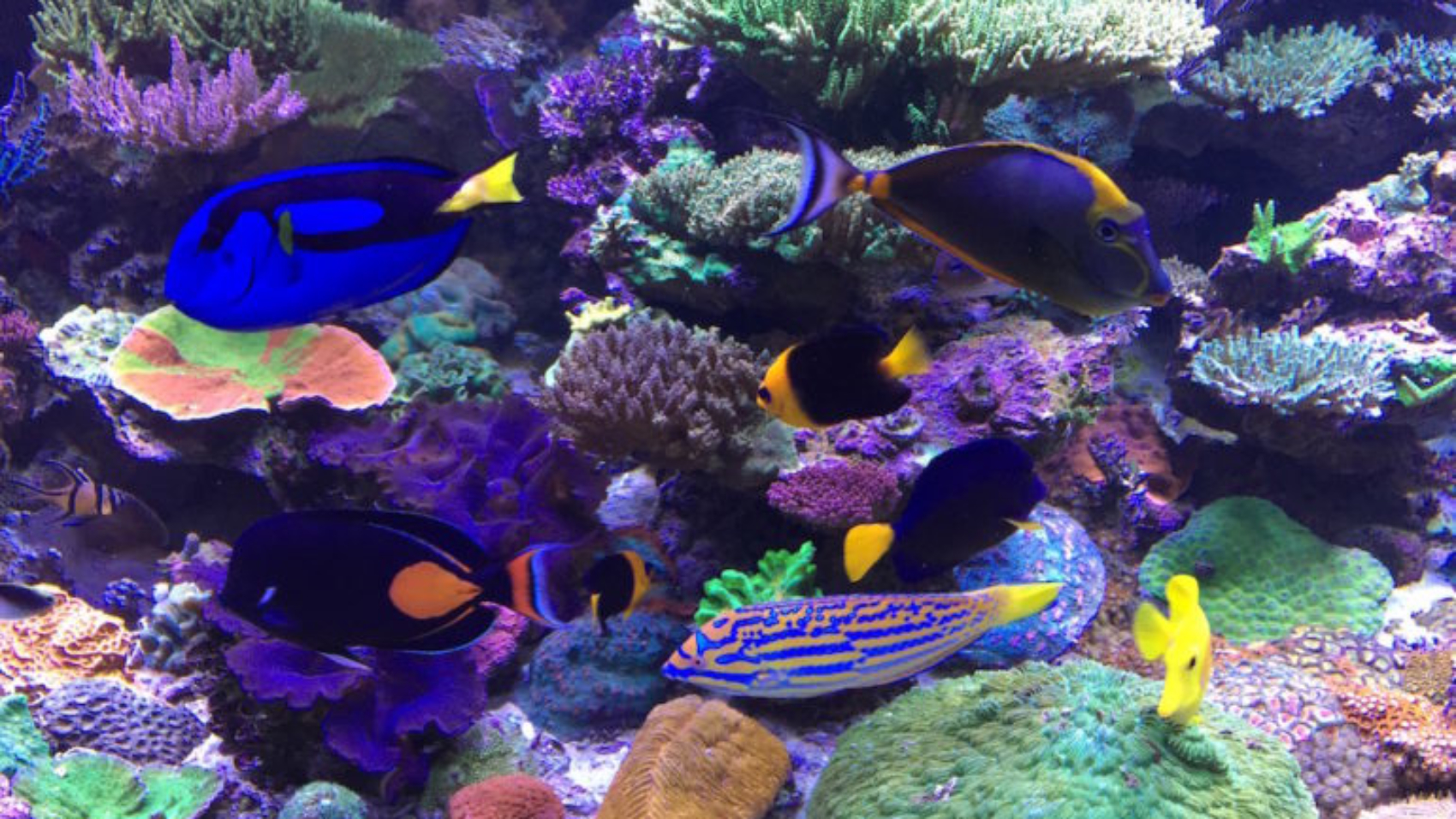Author: Jeff Kurtz
“I understand saltwater aquariums are a lot of hard work. How many hours do you have to spend on yours each day to keep it looking like that?”
“I’d love to start a saltwater tank, but I just don’t have enough time in my schedule to maintain one.”
“Sure, saltwater aquariums are beautiful, but aren’t they much more difficult than freshwater?”
Questions and comments such as these, which are frequently uttered to marine aquarium hobbyists by their non-hobbyist acquaintances, drive home the point that some long-standing misconceptions still persist about marine aquarium keeping. Foremost among them is the notion that maintaining a healthy marine system requires a prohibitive investment of time and effort each day.
The truth of the matter is on most days I spend no more (and usually less) than 15 minutes performing aquarium maintenance. Sure, there are those water-change days that take up a few hours, but all in all I would describe the overall investment of time and elbow grease as quite modest—and certainly no worse than what you might expect from any other hobby or avocation.
Still, preparing for this month’s column has got me thinking about how I typically divvy up my aquarium-maintenance chores and how I could provide a sample maintenance schedule for those who are considering taking the plunge into saltwater aquarium keeping but may be discouraged by the amount of time and energy that they think the hobby demands. What follows is my best attempt to dissect a maintenance routine that, for me, has become largely subconscious and second nature. Another hobbyist’s routine might look significantly different, depending on the animals kept and the complexity of the system, but hopefully this will give newcomers a sense of what they can expect.
Along with feeding my fish twice daily (once in the morning and once in the evening), I top off fresh water lost to evaporation—usually about a half gallon a day, depending on the humidity level in my home. This process can be fairly easily automated, however, eliminating even this simple step.
Each day’s routine also involves an inspection of all the livestock in my tank. I want to make sure that all the animals are present and accounted for (i.e., nothing has perished in the rockwork or leapt from the tank) and that everything looks healthy, uninjured, and disease-free. This really isn’t much of a chore, since it gives me an excuse to observe the tank and enjoy the fruits of my labor.
Then I check water temperature and specific gravity to make sure these crucial parameters aren’t straying off course. Monitoring these parameters daily allows me to catch and correct subtle deviations using small adjustments rather than having to make huge (read: stressful to tank inhabitants) corrections after a precipitous change has occurred.
I also perform a quick daily inspection of all my heating, filtration, lighting, and protein-skimming equipment to make sure everything is functioning properly. I find it helpful to run my hand along the various lines, tubes, and connections to make sure everything is properly plugged in (I have a habit of leaving my heater unplugged after water changes) or connected and that I don’t feel any moisture from small leaks.
Because I keep corals and a Tridacna clam in my system, my daily routine includes the addition of calcium and a buffering agent. However, if you plan to set up a fish-only system, this step would be unnecessary.
Finally, each day I empty and rinse out the collection cup of my protein skimmer to prevent an overflow, and I wipe off any salt creep (not your humble author, but that crusty salt layer that builds up on surfaces exposed to saltwater spray) that is accumulating on power cords and other surfaces. You have to be especially cautious about salt creep on power cords, as it can eventually work its way down the cord into the electrical outlet, causing a short.
This may sound like a lot to do each day, but again, these are all very simple steps and virtually all of them can be completed in a matter of minutes.
Once a week, it’s a good idea to test your ammonia, nitrite, nitrate, and phosphate levels with quality test kits to ensure your tank isn’t experiencing a spike in any of these compounds. As a reef keeper, I also test calcium and alkalinity to make sure they’re in the proper range. Once your system has matured and you’ve developed a certain level of comfort and proficiency in your maintenance techniques—and assuming you aren’t continually adding or losing livestock—you may be able to get by testing less frequently.
My weekly housekeeping also includes cleaning the glass panes of my aquarium with an algae magnet (sometimes I do this as often as every other day, depending on how quickly the glass becomes fouled), wiping clean the neck of my protein skimmer to improve its efficiency, and rinsing my prefilter sponges to eliminate any trapped debris from the system before it can decompose and adversely impact my water quality.
The most important routine maintenance chore—the partial water change—should be completed once every two weeks or, at the very least, once a month. In heavily populated tanks or tanks containing large specimens that excrete on the heavy side, weekly water changes would be even better. A good rule to remember is that frequent, smaller water changes (approximately 10 percent of your aquarium’s water) are preferable to infrequent, larger water changes, which are more disruptive to the tank inhabitants and result in larger fluctuations in water chemistry.
Of course, there may be times when a larger change is required—for example, if you have a really heavy bioload, or if testing reveals that nitrate, phosphate, or some other pollutant is beginning to accumulate and, hence, greater dilution is called for. In these cases, the potential harm to the system that is posed by the accumulating pollutant significantly outweighs any disruption that might result from a major water change.
A few days before or after every water change, it’s a good idea to replace disposable mechanical filtration media (if using a canister filter, hang-on-tank filter, etc.). Why not do this on the same day as your water change for the sake of convenience? Because dividing these tasks over different days helps to minimize any disruption to your system’s biological filtration. Remember, nitrifying bacteria will colonize mechanical filter media, so replacing them at the same time that you vacuum the substrate, scrape the glass, and perform other cleaning chores can diminish the population of these beneficial bacteria to the point that an ammonia or nitrite spike can occur.
Once a month, I also clean my aquarium cover glass as well as the acrylic shield of my lighting fixture. Over time, these develop a crust of salt and calcium deposits, which reduces the amount of light that reaches the photosynthetic invertebrates in my system. Salt can be cleaned off easily with a damp cloth. Calcium deposits are a bit tougher to clean but can be removed by wiping vigorously with a sponge or cloth soaked with white vinegar. For the sake of convenience this chore can be completed at the same time as one of your biweekly water changes.
Incidentally, approximately once a month I also use white vinegar to soak the air intake hose and valves of my protein skimmer to prevent them from becoming clogged with calcium. Clogged skimmer valves throw the mixture of air and water out of balance, which results in poor foam production and overly diluted skimmate. After soaking the valves for a while, I use a small aquarium brush (or sometimes a flathead jeweler’s screwdriver) to dislodge any remaining calcium buildup.
Every other month or so (extra emphasis on the “or so”), I like to spend a little extra time cleaning any accumulated gunk from my protein skimmer, return pump, biofilter overflow box, powerhead, heater, thermometer, and hoses, using aquarium brushes of various sizes and, for some tasks, a razor blade. The buildup of coralline algae that develops on submerged marine aquarium components can really affect their performance over time, so I try to keep this growth from getting out of hand. If the coralline encrustation does become excessive, say on one of the pumps, a prolonged soaking in (you guessed it) white vinegar coupled with some vigorous scrubbing usually does the trick.
When the inside of my return hose becomes coated with gunk that can’t be flushed out with tap water, there’s a simple little trick I use to get it clean. I take an appropriately sized aquarium brush, tie a length of flexible airline tubing (longer than the hose being cleaned) to the loop at the end of the handle, thread the airline tubing through the hose so it emerges at the far end, and then pull the brush through the hose. After two or three passes, the inside of the hose usually comes clean.
I don’t generally use activated carbon in my system, except very occasionally to “polish” the water a bit. But some aquarists choose to utilize carbon continually. If carbon is a mainstay in your filtration arsenal, it should be replaced with fresh carbon approximately once every two months. The reason for this is that carbon left in a system too long can become used up and then “dump” the adsorbed chemical pollutants back into the water, defeating the purpose of using carbon in the first place.
Reef keepers have another very easy but also extremely important chore to keep in mind, and it only rolls around every six months to a year—replacing the bulbs and/or tubes in their lighting systems. Lighting of the proper color and intensity is crucial to the survival of photosynthetic invertebrates. However, as the lamps age, they tend to lose intensity and undergo a shift in spectral characteristics. Hence, they must be replaced at regular intervals according to manufacturer’s recommendations, lest the invertebrates suffer as a result of the diminishing light quality. Since so much time elapses in between lamp changes, and the shift in light quality occurs very gradually and is not necessarily discernible to the human eye, it’s easy to overlook this chore until too much time has passed. To avoid this potentially costly (for your livestock) error, it’s recommended that you mark on a calendar the day you installed the lamps, as well as the day they should be replaced based on the manufacturer’s recommended schedule.
As I’ve already mentioned, this aquarium maintenance schedule may differ considerably from that of another hobbyist. And the time and effort that it takes will vary based on the size and complexity of the system, the number and type of animals being kept, and the presence or absence of time saving automated equipment. But as you can hopefully see, maintaining a marine aquarium—even a reef system—does not have to tie up several hours each day. A very modest but consistent investment of time and energy will yield a thriving marine aquarium that you can be proud of.
Source:Tfhmagazine


Add a Comment
You must be logged in to post a comment